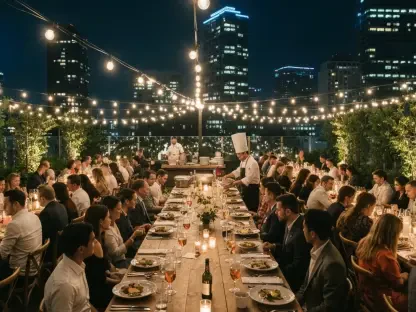Allow me to introduce Katarina Railko, a seasoned expert in hospitality management with a wealth of experience in the travel and tourism industry. Her extensive background in entertainment and events, coupled with her passion for expos and conferences, makes her a prominent voice in the field. Today, we dive into her insights on leadership transitions, property transformations, and the evolving landscape of the hotel industry, drawing from recent general manager appointments at various prestigious properties. Join us as we explore her perspectives on career journeys, renovation projects, team-building strategies, and visions for iconic hotels.
How do you see a long-term career in hospitality shaping a leader’s approach to managing high-profile properties?
I think a long career in hospitality, spanning decades like some of these recent appointees, builds a deep well of resilience and adaptability. Over 30 years, for example, you encounter every kind of challenge—economic downturns, changing guest expectations, and even large-scale crises. This experience teaches you to anticipate issues before they arise and to pivot quickly. It also hones your ability to connect with diverse teams and guests, which is critical when managing iconic properties. For me, the biggest takeaway from such a journey is learning to balance tradition with innovation—respecting a hotel’s legacy while pushing for modern relevance.
What goes into leading a massive renovation project, like a $100 million overhaul of a luxury resort?
Leading a project of that scale is a blend of vision, precision, and patience. You start by defining clear goals—whether it’s enhancing guest experience, updating infrastructure, or rebranding to attract a new demographic. Then, it’s about assembling the right team, from architects to contractors, and ensuring everyone aligns on the vision. Budget management is huge; you’re constantly tracking costs to avoid overruns while maintaining quality. I’ve seen how critical it is to communicate with stakeholders at every step to keep trust and momentum. Ultimately, it’s about creating a space that feels fresh yet timeless, all while minimizing disruption to operations.
How do industry roles, like leading a regional hospitality association, complement the day-to-day responsibilities of a general manager?
Taking on a role in a hospitality association adds a broader perspective to your daily work as a general manager. It connects you with industry trends, policy changes, and networking opportunities that directly impact your property. For instance, advocating for local tourism initiatives can drive more business to your hotel. It’s also a chance to give back by mentoring others or shaping regulations that benefit the sector. Balancing this with property management requires strong time management—carving out space for association work without neglecting your team or guests. I’ve found it energizes me, bringing fresh ideas back to my hotel.
What excites you most about stepping into a new general manager role at a property with a unique identity?
There’s nothing quite like the thrill of taking the helm at a property with its own story and character. It’s an opportunity to immerse yourself in its history and culture while leaving your own mark. What excites me is the chance to build on what’s already special—whether it’s the location, design, or legacy—and elevate it through personalized guest experiences. I love envisioning how to position the hotel in its market, whether by enhancing amenities or creating signature events. Drawing from past roles, I focus on understanding the team’s strengths first, as they’re the ones who bring that vision to life.
What’s the most rewarding aspect of a career in hospitality, especially when you’ve been in the industry for over a decade?
For me, the most rewarding part is seeing the impact you have on people—both guests and staff. Over 14 years or more, you collect moments where a guest’s stay becomes a cherished memory, or a team member grows under your guidance into a leader themselves. I recall a time when a small gesture, like personalizing a guest’s welcome, turned into a lifelong connection with that family returning year after year. Those human connections are the heart of hospitality. It’s not just about numbers or awards; it’s about creating a space where people feel valued and inspired.
How do you approach the challenge of opening a new hotel and building a cohesive team from scratch?
Opening a new hotel is like painting on a blank canvas—it’s exciting but daunting. My approach starts with defining the hotel’s identity and culture from day one. I prioritize hiring people who align with that vision, not just in skills but in passion for service. Building a team from scratch means fostering trust early through open communication and hands-on training. I’m often on the floor with them, showing rather than telling. Challenges like delayed openings or staff turnover are common, but I tackle them by staying flexible and keeping morale high—celebrating small wins helps everyone stay motivated.
What qualities or strategies do you think help a general manager stand out and earn industry recognition?
Standing out as a general manager comes down to a mix of innovation, empathy, and results. It’s about consistently exceeding expectations—whether through unique guest experiences or operational efficiency. I’ve seen leaders earn recognition by taking calculated risks, like introducing a bold new concept that redefines their hotel’s appeal. Equally important is how you treat your team; inspiring them to deliver exceptional service creates a ripple effect. I focus on active listening—to staff, guests, and even market trends—to stay ahead. Recognition often follows when you’re genuinely invested in lifting everyone around you.
How do you craft a vision for a new property to ensure it stands out in a competitive market?
Crafting a vision starts with understanding the market and the property’s unique selling points. Is it the location, the design, or a niche audience you can target? I dive deep into what makes the area tick—local culture, events, or even food scenes—and weave that into the hotel’s identity. From there, it’s about creating experiences that guests can’t get elsewhere, like curated events or partnerships with local artisans. I also involve the team in shaping this vision; their buy-in is crucial for authentic delivery. Differentiation comes from storytelling—making sure every guest interaction reflects what sets the property apart.
What is your forecast for the future of boutique and lifestyle hotels in competitive regions like the Central Coast of California?
I’m incredibly optimistic about the future of boutique and lifestyle hotels, especially in regions like California’s Central Coast where travelers crave authentic, personalized experiences. These properties are well-positioned to capitalize on the growing demand for unique stays over cookie-cutter chains. I foresee a continued emphasis on local integration—think farm-to-table dining or eco-friendly initiatives that resonate with the area’s ethos. Technology will also play a bigger role, enhancing guest customization without losing that intimate touch. The challenge will be balancing growth with maintaining that boutique charm, but with creative leadership, these hotels can thrive as destinations in their own right.









